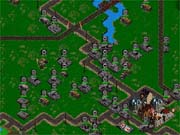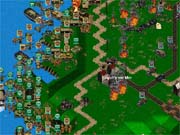Fortress Europe might make you think that Matrix Games is trying to kill wargaming. The company recommends it for novice wargamers, which is a surefire way to send someone screaming to another genre, never to look back. This sadly disorganized, poorly documented, hideously ugly, surprisingly overpriced, and downright inscrutable jumble is one of the worst things to happen to wargaming since Hasbro butchered Avalon Hill's Squad Leader.

Fortress Europe is an operational-level wargame covering the Allied invasion of Normandy and the eventual liberation of France. It runs in real time at a rate of about a half hour of game time for each day, but you can pause to give orders to your troops. The game's units are generic representations of infantry, armor, or artillery, each with limited amounts of fuel and ammo. Weather kicks up from time to time in the form of thunderstorms. In addition to moving units and giving them targets, you can call in air strikes, drop paratroopers, place minefields, or float barrage balloons. As units take over territory, they earn victory points for their side based on the type of territory. A color-coded display shows how much of the map each side controls.
Beyond this, it's hard to explain Fortress Europe because it's so poorly documented that you'll just have to guess what's going on. If you hunt around on the CD, you'll find a woefully inadequate 10-page PDF file that serves as a manual. There are a handful of salient details here, but mainly a lot of unanswered questions. OK, so you can order concentrated attacks and synchronized attacks. Why? What do they do? How do they work? OK, so you can call in air strikes. Why does this only occasionally work? What good are barrage balloons at preventing them? Are there any active antiair defenses? OK, so units are organized into the historical hierarchies of the divisions that actually landed at Normandy and defended it. Is there some sort of command and control scheme at work? Is there any way to bring in replacements to depleted units? How do you resupply a unit with fuel and ammo?
Fortress Europe is a wargame without numbers, which might be good in theory. In practice, it just means there's no way to tell the relative value of things. How good are different units at attacking and defending? Does terrain have any effect on combat? What does the weather do? Do my units ever need to rest? Is morale ever an issue? All of these factors, if they're even present, are completely hidden, and Matrix Games apparently couldn't be bothered to mention any of this in the manual. It hardly feels interactive to just move units with no sense for what they're doing. This might as well be the wargaming equivalent of that electric tabletop football game you had as a kid in which a vibrating table made metal players scoot around the board and jostle each other to minimal effect.
Then there are the issues that aren't even mentioned in the manual. Are those little units running around with a French flag and an "RES" on their counter French resistance fighters? What are they doing? What good are they? Are you supposed to keep that ugly teletype display constantly open if you want to be alerted to new developments? How do the four smaller scenarios work? What difference does it make if I change the starting date?
It's hard to tell where the bugs in Fortress Europe begin, because it's impossible to see where the gameplay ends. For instance, are you supposed to be able to pause the game at any time and ring every single enemy unit with your unlimited supply of minefields? The manual mentions a way to bring up detailed information on a unit, but it doesn't work. Is this a bug or was this feature cut? Are there victory conditions or even a way to display the score? Is there a way to end the game? Can the Germans ever lose? As a test, we started a game as the Germans, with the computer AI controlling the Allies. We came back 13 hours later and the game was still going, but the date had lapsed into some strange negative numbers. So we ended the game, having never given the Germans a single order, and were greeted with the screen for a German victory. Apparently, your participation in Fortress Europe is optional, which is bad news for those who get duped into shelling out $40 to play a game that doesn't even need you.

The graphics are ugly, cluttered, and slow. With such blatantly cartoony 2D sprites, it's hard to tell why the game is so choppy and the system requirements are so high. Even on a higher-end computer, it takes several seconds to change screens. The interface is a collection of buttons and a laughable cursor that shows a commanding officer throwing out a hearty "Sieg Heil," regardless of his actual nationality. The only information available on a unit is its health bar. For some reason, you can manually change unit and turret facing. Not only is this a nightmare of micromanagement considering the hundreds of units involved, but it's completely inconsistent with the scale being modeled.
The publisher of Fortress Europe is Matrix Games, one of the few havens for small developers who want to write games for niche audiences. We have Matrix Games to thank for making available updates of SSI's Steel Panthers and Gary Grigsby's classics, War in Russia and Pacific War. Matrix Games is also publishing Vicious Byte's Titans of Steel mech game, Andrew Ewanchyna's Starships Unlimited, and the first title from Grigsby's new company, 2by3 Games. But this makes it all the more distressing to see the company selling something as obviously sloppy as Fortress Europe, a wretched underdone mess that has no business being sold in its current state.